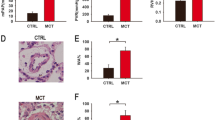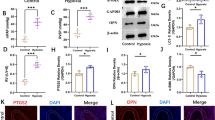Abstract
Previous studies have reported the important roles of long non-coding RNAs (lncRNAs) in acute respiratory distress syndrome (ARDS). Here, we focus on the role and regulatory mechanism of lncRNA SNHG5 in ARDS. LPS was used to induce mice to establish ARDS model in vivo and to induce A549 cells to establish ARDS model in vitro. qRT-PCR was performed to determine the expressions of SNHG5, miR-205, and inflammatory cytokines. MTT assay was applied to detect cell viability. Dual-luciferase reporter (DLR) assay was performed to test the interactions among SNHG5, miR-205 and COMMD1. Western blot was used to detect the protein expression of COMMD1. Lung injury was evaluated by evaluating the score of lung injury, lung wet/dry weight ratio, and myeloperoxidase (MPO) activity. SNHG5 was downregulated, while miR-205 was upregulated in the serum of ARDS patients and lung tissues of LPS-induced mice. Upregulation of SNHG5 or down-regulation of miR-205 inhibited inflammation and promoted the viability of LPS-induced A549 cells. SNHG5 alleviated the lung injury of ARDS mice. MiR-205 was a target of SNHG5 and inversely correlated with SNHG5. COMMD1 was targeted by miR-205, and was positively regulated by SNHG5. MiR-205 mimics or sh-COMMD1 reversed the promoting effect of SNHG5 on cell viability and the suppressing effect of SNHG5 on inflammation in cellular model of ARDS. Meantime, miR-205 mimics reversed the relieving effect of SNHG5 on lung injury in mouse model of ARDS. SNHG5 acted as a sponge for miR-205 to ameliorate LPS-induced ARDS by regulating COMMD1.







Similar content being viewed by others
Availability of data and material
All data in the manuscript is available through the responsible corresponding author.
References
Maria A, Agarwal S, Sharma A (2017) Acute respiratory distress syndrome in a neonate due to possible transfusion-related acute lung injury. Asian J Transfus Sci 11(2):203–205. https://doi.org/10.4103/ajts.AJTS_120_16
Zhang Y, Ding S, Li C, Wang Y, Chen Z, Wang Z (2017) Effects of N-acetylcysteine treatment in acute respiratory distress syndrome: a meta-analysis. Exp Ther Med 14(4):2863–2868. https://doi.org/10.3892/etm.2017.4891
Chiumello D, Brochard L, Marini JJ, Slutsky AS, Mancebo J, Ranieri VM, Thompson BT, Papazian L, Schultz MJ, Amato M, Gattinoni L, Mercat A, Pesenti A, Talmor D, Vincent JL (2017) Respiratory support in patients with acute respiratory distress syndrome: an expert opinion. Crit Care 21(1):240. https://doi.org/10.1186/s13054-017-1820-0
Laffey JG, Misak C, Kavanagh BP (2017) Acute respiratory distress syndrome. BMJ 359:j5055. https://doi.org/10.1136/bmj.j5055
Kissoon N, Daniels R, van der Poll T, Finfer S, Reinhart K (2016) Sepsis-the final common pathway to death from multiple organ failure in infection. Crit Care Med 44(6):e446. https://doi.org/10.1097/CCM.0000000000001582
Derwall M, Martin L, Rossaint R (2018) The acute respiratory distress syndrome: pathophysiology, current clinical practice, and emerging therapies. Expert Rev Respir Med 12(12):1021–1029. https://doi.org/10.1080/17476348.2018.1548280
Villar J, Blanco J, Anon JM, Santos-Bouza A, Blanch L, Ambros A, Gandia F, Carriedo D, Mosteiro F, Basaldua S, Fernandez RL, Kacmarek RM (2011) The ALIEN study: incidence and outcome of acute respiratory distress syndrome in the era of lung protective ventilation. Intensive Care Med 37(12):1932–1941. https://doi.org/10.1007/s00134-011-2380-4
Uszczynska-Ratajczak B, Lagarde J, Frankish A, Guigo R, Johnson R (2018) Towards a complete map of the human long non-coding RNA transcriptome. Nat Rev Genet 19(9):535–548. https://doi.org/10.1038/s41576-018-0017-y
Wang S, Cao F, Gu X, Chen J, Xu R, Huang Y, Ying L (2019) LncRNA XIST, as a ceRNA of miR-204, aggravates lipopolysaccharide-induced acute respiratory distress syndrome in mice by upregulating IRF2. Int J Clin Exp Pathol 12(7):2425–2434
Wang Y, Fu X, Yu B, Ai F (2019) Long non-coding RNA THRIL predicts increased acute respiratory distress syndrome risk and positively correlates with disease severity, inflammation, and mortality in sepsis patients. J Clin Lab Anal 33(6):e22882. https://doi.org/10.1002/jcla.22882
Yao MY, Zhang WH, Ma WT, Liu QH, Xing LH, Zhao GF (2020) Long non-coding RNA MALAT1 exacerbates acute respiratory distress syndrome by upregulating ICAM-1 expression via microRNA-150-5p downregulation. Aging 12(8):6570–6585. https://doi.org/10.18632/aging.102953
Zhao L, Han T, Li Y, Sun J, Zhang S, Liu Y, Shan B, Zheng D, Shi J (2017) The lncRNA SNHG5/miR-32 axis regulates gastric cancer cell proliferation and migration by targeting KLF4. FASEB J 31(3):893–903. https://doi.org/10.1096/fj.201600994R
Ichigozaki Y, Fukushima S, Jinnin M, Miyashita A, Nakahara S, Tokuzumi A, Yamashita J, Kajihara I, Aoi J, Masuguchi S, Zhongzhi W, Ihn H (2016) Serum long non-coding RNA, snoRNA host gene 5 level as a new tumor marker of malignant melanoma. Exp Dermatol 25(1):67–69. https://doi.org/10.1111/exd.12868
Wang Z, Pan L, Yu H, Wang Y (2018) The long non-coding RNA SNHG5 regulates gefitinib resistance in lung adenocarcinoma cells by targetting miR-377/CASP1 axis. Biosci Rep. https://doi.org/10.1042/BSR20180400
Shen Q, Zheng J, Wang X, Hu W, Jiang Y (2020) LncRNA SNHG5 regulates cell apoptosis and inflammation by miR-132/PTEN axis in COPD. Biomed Pharmacother 126:110016. https://doi.org/10.1016/j.biopha.2020.110016
Lewis BP, Burge CB, Bartel DP (2005) Conserved seed pairing, often flanked by adenosines, indicates that thousands of human genes are microRNA targets. Cell 120(1):15–20. https://doi.org/10.1016/j.cell.2004.12.035
Liu Q, Du J, Yu X, Xu J, Huang F, Li X, Zhang C, Chang J, Shang D, Zhao Y, Tian M, Lu H, Li C, Zhu H, Jin N, Jiang C (2017) miRNA-200c-3p is crucial in acute respiratory distress syndrome. Cell Discov 3:17021. https://doi.org/10.1038/celldisc.2017.21
Li P, Yao Y, Ma Y, Chen Y (2019) MiR-150 attenuates LPS-induced acute lung injury via targeting AKT3. Int Immunopharmacol 75:105794. https://doi.org/10.1016/j.intimp.2019.105794
Liang Y, Xie J, Che D, Zhang C, Lin Y, Feng L, Chen J, Chen L, Wu Z (2020) MiR-124–3p helps to protect against acute respiratory distress syndrome by targeting p65. Biosci Rep 40(5):1. https://doi.org/10.1042/BSR20192132
Yu X, Chen X, Sun T (2019) MicroRNA-205-5p targets HMGB1 to suppress inflammatory responses during lung injury after hip fracture. Biomed Res Int 2019:7304895. https://doi.org/10.1155/2019/7304895
Sun B, Xu S, Yan Y, Li Y, Li H, Zheng G, Dong T, Bai J (2020) miR-205 suppresses pulmonary fibrosis by targeting GATA3 through inhibition of endoplasmic reticulum stress. Curr Pharm Biotechnol 21(8):720–726. https://doi.org/10.2174/1389201021666191210115614
Lei J, Wei Y, Song P, Li Y, Zhang T, Feng Q, Xu G (2018) Cordycepin inhibits LPS-induced acute lung injury by inhibiting inflammation and oxidative stress. Eur J Pharmacol 818:110–114. https://doi.org/10.1016/j.ejphar.2017.10.029
Dai L, Zhang G, Cheng Z, Wang X, Jia L, Jing X, Wang H, Zhang R, Liu M, Jiang T, Yang Y, Yang M (2018) Knockdown of LncRNA MALAT1 contributes to the suppression of inflammatory responses by up-regulating miR-146a in LPS-induced acute lung injury. Connect Tissue Res 59(6):581–592. https://doi.org/10.1080/03008207.2018.1439480
Zhu J, Bai J, Wang S, Dong H (2019) Down-regulation of long non-coding RNA SNHG14 protects against acute lung injury induced by lipopolysaccharide through microRNA-34c-3p-dependent inhibition of WISP1. Respir Res 20(1):233. https://doi.org/10.1186/s12931-019-1207-7
Tsai CL, Lin YC, Wang HM, Chou TC (2014) Baicalein, an active component of Scutellaria baicalensis, protects against lipopolysaccharide-induced acute lung injury in rats. J Ethnopharmacol 153(1):197–206. https://doi.org/10.1016/j.jep.2014.02.010
Jabaudon M, Blondonnet R, Roszyk L, Bouvier D, Audard J, Clairefond G, Fournier M, Marceau G, Dechelotte P, Pereira B, Sapin V, Constantin JM (2015) Soluble receptor for advanced glycation end-products predicts impaired alveolar fluid clearance in acute respiratory distress syndrome. Am J Respir Crit Care Med 192(2):191–199. https://doi.org/10.1164/rccm.201501-0020OC
Li HB, Zi PP, Shi HJ, Gao M, Sun RQ (2018) Role of signaling pathway of long non-coding RNA growth arrest-specific transcript 5/microRNA-200c-3p/angiotensin converting enzyme 2 in the apoptosis of human lung epithelial cell A549 in acute respiratory distress syndrome. Zhonghua Yi Xue Za Zhi 98(41):3354–3359. https://doi.org/10.3760/cma.j.issn.0376-2491.2018.41.013
Zhou H, Wang X, Zhang B (2020) Depression of lncRNA NEAT1 antagonizes LPS-evoked acute injury and inflammatory response in alveolar epithelial cells via HMGB1-RAGE signaling. Mediat Inflamm 2020:8019467. https://doi.org/10.1155/2020/8019467
Shen H, Wang Y, Shi W, Sun G, Hong L, Zhang Y (2018) LncRNA SNHG5/miR-26a/SOX2 signal axis enhances proliferation of chondrocyte in osteoarthritis. Acta Biochim Biophys Sin 50(2):191–198. https://doi.org/10.1093/abbs/gmx141
Gao J, Zeng K, Liu Y, Gao L, Liu L (2019) LncRNA SNHG5 promotes growth and invasion in melanoma by regulating the miR-26a-5p/TRPC3 pathway. Onco Targets Ther 12:169–179. https://doi.org/10.2147/OTT.S184078
Lin Y, Ding Y, Song S, Li M, Wang T, Guo F (2019) Expression patterns and prognostic value of miR-210, miR-494, and miR-205 in middle-aged and old patients with sepsis-induced acute kidney injury. Bosn J Basic Med Sci 19(3):249–256. https://doi.org/10.17305/bjbms.2019.4131
Fu JY, Yu XF, Wang HQ, Lan JW, Shao WQ, Huo YN (2020) MiR-205-3p protects human corneal epithelial cells from ultraviolet damage by inhibiting autophagy via targeting TLR4/NF-kappaB signaling. Eur Rev Med Pharmacol Sci 24(12):6494–6504. https://doi.org/10.26355/eurrev_202006_21632
Meng X, Deng Y, Lv Z, Liu C, Guo Z, Li Y, Liu H, Xie B, Jin Z, Lin F, Zhu H (2019) LncRNA SNHG5 promotes proliferation of glioma by regulating miR-205-5p/ZEB2 axis. Onco Targets Ther 12:11487–11496. https://doi.org/10.2147/OTT.S228439
He B, Bai Y, Kang W, Zhang X, Jiang X (2017) LncRNA SNHG5 regulates imatinib resistance in chronic myeloid leukemia via acting as a CeRNA against MiR-205-5p. Am J Cancer Res 7(8):1704–1713
Xiang W, Lv L, Zhou G, Wu W, Yuan J, Zhang C, Jiang G (2020) The lncRNA SNHG5-mediated miR-205-5p downregulation contributes to the progression of clear cell renal cell carcinoma by targeting ZEB1. Cancer Med 9(12):4251–4264. https://doi.org/10.1002/cam4.3052
Maine GN, Burstein E (2007) COMMD proteins and the control of the NF kappa B pathway. Cell Cycle 6(6):672–676. https://doi.org/10.4161/cc.6.6.3989
Ning R, Zhang X, Guo X, Li Q (2010) Attachment of Staphylococcus aureus is required for activation of nuclear factor kappa B in human osteoblasts. Acta Biochim Biophys Sin 42(12):883–892. https://doi.org/10.1093/abbs/gmq096
de Becdelievre A, Rocca J, Aissat A, Drevillon L, Moutereau S, Le Gouvello S, Hinzpeter A, Tarze A, Fanen P (2013) COMMD1 modulates noxious inflammation in cystic fibrosis. Int J Biochem Cell Biol 45(11):2402–2409. https://doi.org/10.1016/j.biocel.2013.07.012
Besiktepe N, Kayalar O, Ersen E, Oztay F (2017) The copper dependent-lysyl oxidases contribute to the pathogenesis of pulmonary emphysema in chronic obstructive pulmonary disease patients. J Trace Elem Med Biol 44:247–255. https://doi.org/10.1016/j.jtemb.2017.08.011
Yeh DW, Chen YS, Lai CY, Liu YL, Lu CH, Lo JF, Chen L, Hsu LC, Luo Y, Xiang R, Chuang TH (2016) Downregulation of COMMD1 by miR-205 promotes a positive feedback loop for amplifying inflammatory- and stemness-associated properties of cancer cells. Cell Death Differ 23(5):841–852. https://doi.org/10.1038/cdd.2015.147
Tay Y, Rinn J, Pandolfi PP (2014) The multilayered complexity of ceRNA crosstalk and competition. Nature 505(7483):344–352. https://doi.org/10.1038/nature12986
Funding
Heilongjiang Provincial Health and Family Planning Commission approved a scientific research Project, No. 2018-222. Project Name: Study on peripheral blood immune response of NRDS by HFOV combined with exogenous PS.
Author information
Authors and Affiliations
Contributions
JW and YZ: conception and design and analysis of data. JW, YZ and LZ: performed the experiment. JW and YZ: drafting the article. LZ: revising the article critically for important intellectual content. JW and YZ: performed the data. LZ: helped perform the analysis with constructive discussions. All the authors read and approved the manuscript.
Corresponding author
Ethics declarations
Conflict of interest
The Authors declare that they have no conflict of interest to disclose.
Ethics approval
This study was approved by the ethics committee of The First Affiliated Hospital of Jiamusi University. Written informed consent was obtained from all subjects.
Additional information
Publisher's Note
Springer Nature remains neutral with regard to jurisdictional claims in published maps and institutional affiliations.
Rights and permissions
About this article
Cite this article
Wang, J., Zhang, Y. & Zhang, L. Long non-coding RNA SNHG5 suppresses the development of acute respiratory distress syndrome by targeting miR-205/COMMD1 axis. Mol Cell Biochem 476, 1063–1074 (2021). https://doi.org/10.1007/s11010-020-03972-8
Received:
Accepted:
Published:
Issue Date:
DOI: https://doi.org/10.1007/s11010-020-03972-8




